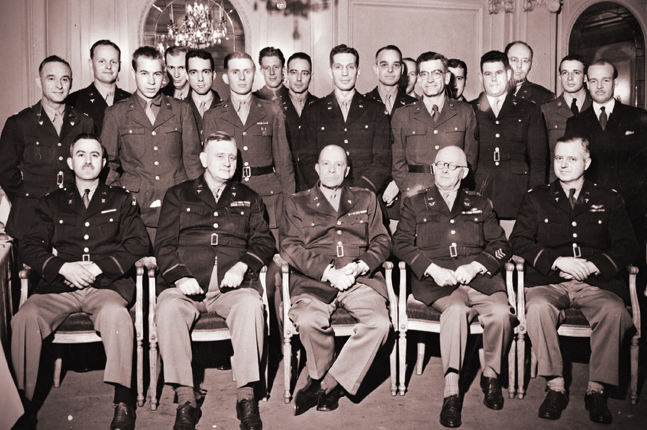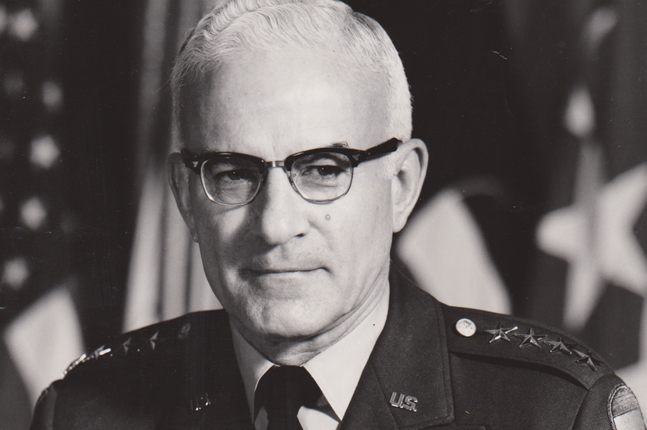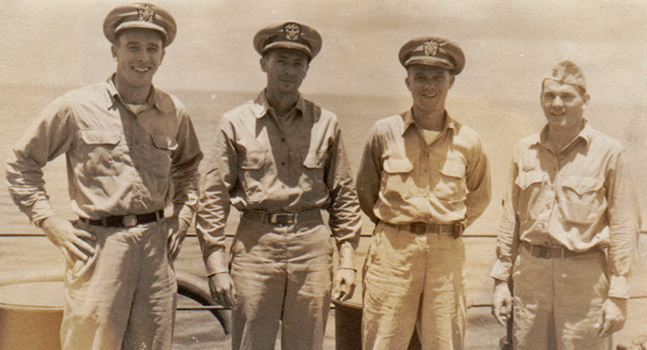An estimated 12,233 initiated members of Phi Delta Theta served in World War II, 559 killed in action.
From Six at First history by Walter E. Havighurst, Ohio Wesleyan ’23
On Sunday afternoon, December 7, 1941, in the hundred chapter houses undergraduate Phis were lounging by the fireside when radio programs were interrupted by an astounding news bulletin. Without warning Japanese naval and air forces had struck Pearl Harbor Naval Base in Hawaii. Of the eight battleships at Peral Harbor three were sunk, one was grounded, one capsized, and three were severely damaged. On December 19 Congress extended military conscription to men of age 20 to 44. In the chapter houses young men packed their bags for Christmas vacation, wondering how the second World War would shape their future.
In January 1942, hundreds of colleges announced a list of war emergency courses for the new term. Such offerings as meteorology, navigation, cartography, signaling and communications, and production management were designed to prepare students for service in war industry and in the armed forces.
At the 1942 General Convention in Chicago, Brother George Housser, McGill ’06, was elected to the General Council. Former province president, this rugged man, bronzed and crew-cut, had an outdoor look, offering a ‘steady hand to seer our ship in these sullen, troubled times.” Also, at convention, magnetic, white-haired Hilton U. Brown, Butler ’80, last of the patriarchs and the first two-term president of the Fraternity, spoke to a hushed convention hall. He told of the long line of Phis, many now in distant zones of war. “But the line,” he said, “will not be broken, because the Fraternity’s life is continuous, with a mystic cord binding one generation to another.
During the war’s first winter students began enlisting in military units. Others joined volunteer training programs. Within months, military officers arrived on many campuses to set up basic training for the Army, Navy, and Air Corps. Thousands of Phis enlisted in these units.
To Phis in uniform, chapter newsletters told what was happening on campus and brought word from members in the armed forces. Miami alumnus, Harry Gerlach, ’30, sent the bi-monthly Fighting Phi News. This mimeographed sheet became an exchange of experience, of memories, and of military addresses. It enabled men to find each other in distant camps and bases and led to some rare reunions in strange parts of the world. To more than two hundred Phis from the classes of the 1930s and 40s, this newsletter kept a gleam of fraternity in the long night of war.
The Fighting Phi News was sent to men in flight training, on island beachheads, on naval vessels, in military schools, hospitals, and prisoner of war camps.

By September 1944, medically discharged veterans were returning to the colleges from war. Many spent months in military hospitals before returning to civilian life. In a college editorial, one of the veterans spoke for all. “It is a long way from bullets to books—a long way. The soldier in combat has seen how cheap life can be. He knows how precious it is… The returned student veteran had a part in shaping the future. He knows that this new role of student is not only the greatest of all privileges but is also an obligation born of the blood of men he has known who have perished in battle.”
In WWII Phi Delta Theta contributed 12,233 men to the military forces. They served in all ranks, from seaman and private to four-star general. Among Phi leaders in the war were John Edwin Hull, Miami ’17, Commanding General of Army Forces in the Pacific; Major General Paul R. Hawley, Indiana ’12, Chief Surgeon, European Theater of Operations; Major General Edward P. King, Georgia ’05, artillery commander in the Philippines; Major General Charles P. Hall, Mississippi ’09, commander of the XI Corps in the South Pacific; Vice Admiral Robert P. Ghormley, Idaho ’03, commander of naval forces in the Southwest Pacific; Rear Admiral Wat Tyler Cluverius, Tulane ’95, recalled from retirement to head the US Navy Production Board.

General Bernard William Rogers, Kansas State
Bernard William Rogers, Kansas State, was a United States Army general who served as the 28th Chief of Staff of the United States Army, and later as NATO’s Supreme Allied Commander, Europe and Commander in Chief, United States European Command.
Besides the Distinguished Service Cross, Rogers’ decorations included the Defense Distinguished Service Medal, the Silver Star, four awards of the Legion of Merit and three awards of the Distinguished Flying Cross.
Foremost civilian officials were Robert P. Patterson, Union ’12, Secretary of War; Elmer Davis, Franklin ’10, head of the Office of War Information; and Fred M. Vinson, Centre ’09, Director of War Mobilization and Reconversion.
Phi Delta Theta lost 559 men killed in action. The first Phi casualty came in the opening hour of the war. Ensign William Manley Thompson, North Carolina ’41, went down with the USS Oklahoma in the attack on Pearl Harbor. The last casualty was Vice Admiral John S. McCain, Mississippi ’05, commander of carrier task forces in the Pacific, who died of a heart attack brought on by stress and exhaustion the day after his return from the formal surrender of the Japanese in Tokyo Bay.
(L-R) Warren L. Rockwell, Miami ’42; A. B. Herndon, JR., Florida ’42; L. L. Fergus, Louisiana ’42; James R. Nuzum, West Virginia ’40.
The claim for being the fightin’est alumni chapter afloat was made by the above foursome while aboard a US Navy warship during the operation to capture Peleliu Island from the Japanese. Rockwell is attached to a mine demolition team, while Herndon is an officer on a fast destroyer transport. Fergus is a gunnery officer on a battleship and Nuzum, a shipmate, is a scout-observation pilot.
All four Phis held Lieutenant, Junior Grade rank in the US Navy.




